#business model of food delivery apps
Text
Top 5 Food Delivery Software Solutions for Restaurants in 2023
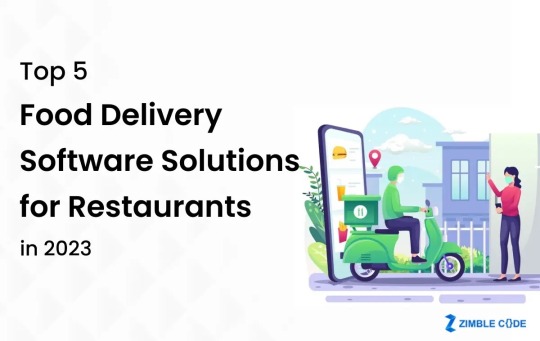
Online meal delivery is still a small portion of the trillion-dollar food sector. This will not only provide you with important information, but it will also show you the techniques they employed to attain their peak position. They have drawn business enthusiasts and people from all around the world. And why not? In fact, it has been predicted that this market will reach USD 0.91 trillion by the end of 2023.
The figures make it quite clear that these applications are now commonplace in the tech sector. The demand for the meal delivery industry is predicted to reach a massive $956 million by 2023. Therefore, now is the ideal moment to start if you intend to ride the popular wagon wheel of online meal delivery.
However, you must first closely examine the dominant food delivery mobile app development solutions that are now dominating the industry. But before that, let us understand what exactly food delivery software is.
Is a Food Delivery Software Solution Worthy?
The task of automating online meal delivery is greatly aided by food delivery management software created by experts at the top mobile app development company in Birmingham. Ensuring that customers receive their orders on time and facilitating communications between patrons, suppliers, and restaurant owners are the main objectives of food ordering software. These apps also make it possible for customers and restaurants to closely monitor orders and deliveries, which unquestionably enhances the delivery experience.
Top Food Delivery Software Solutions for Restaurants
Foodies are a top target market for restaurants. So, it is much simpler to draw them in with restaurant delivery management software to order anything from anywhere. Moreover, food delivery applications are attracting the desired attention of company owners worldwide thanks to their consistently excellent growth.
Here is a list of the best restaurant software solutions by an app development company in Birmingham that you can utilize in 2023
1. Just Eat:

It is one of the UK’s most widely used mobile food ordering applications. The mobile app offers more than 30000 food suppliers listed who provide a variety of meals, including pizza, sushi, fish & chips, kebabs, wraps, and many more. By entering your Pin Code, you may browse the mobile app and get a list of the restaurants that deliver that Pin Code. Along with the name, it will display the cuisine they will deliver, their delivery costs, their minimum order limit, their distance from the Pin Code you provided, and the typical delivery time.
2. Deliveroo:
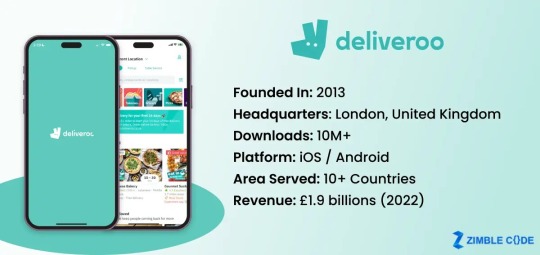
Deliveroo has been a food delivery company for around ten years and is currently accessible in more than ten nations worldwide. The business has teamed up with more than 80,000 food vendors that provide anything from sushi to pizza. Thus, it is the solution for all your meal needs, including late-night ones. It also includes a rating list for each of the meal partners.
3. Domino’s:

One of the well-known pizza companies was established in 1960; Domino’s has 90 foreign markets and branches all over the world. With various deals and discounts, Domino’s mobile app development UK allows you to purchase pizza, sides, beverages, and other items online. The app also offers several special deals only accessible through online purchases.
4. Uber Eats:

More than 50,000 restaurants are partners with Uber Eats. Anything is an option, from KFC to Starbucks. Uber Eats’ remarkable feature is that it gives you information about your designated delivery person, including their name and license plate number. The ordering procedure for food is much easier. All you need to do is enter your ID and password, get access to the Uber Eats platform, and create an account. Next, select the foods you want, choose a payment method, and place your order.
5. Zomato:

‘Foodiebay’ was the original name of the 2008 startup Zomato, an online restaurant search and delivery service. In order to assist other users in deciding whether or not to order and what to get from a restaurant, Zomato now lets users contribute ratings and reviews regarding the delivery service and the restaurant. Additionally, it tells restaurant owners what patrons believe about the cuisine and establishments they run.
Read Also – How UberEats Works: Online Food Delivery App Business Model Explained
Wrapping Up!
Food delivery software is now essential in our technologically advanced society in order to engage customers and provide a smooth experience. This is why using food delivery software equips food delivery app development companies to serve as a conduit between patrons of restaurants and enterprises. In the end, it aids business owners in producing better revenue-based outcomes. If you are also planning to give a new edge to your restaurant business, connect with Zimble Code today and utilize the best-suited food delivery solution!
Article Resource - https://zimblecode.com/top-5-food-delivery-software-solutions-for-restaurants-in-2023/
#App development company in Birmingham#best app developers Birmingham#Best Food Delivery Application Development Services#Build a Food Delivery App like UberEats#business model of food delivery apps#delivery app development company#food delivery app#Food Delivery App Development Company#food delivery app development company in Birmingham#food delivery app development cost#food delivery app development guide#food delivery app development services#Food Delivery App Like UberEats#Food Delivery Apps#food delivery mobile app development#food delivery mobile application development#Food delivery software#Food Delivery Software Solutions#Mobile App Development Company In Birmingham#mobile application development in Birmingham#On-demand food delivery app#on-demand food delivery app development#Top Mobile App Development Company In Birmingham#Top mobile app development company in UK#Web App Development Birmingham#Zimble Code#ZimbleCode uk
1 note
·
View note
Text
Trendsetting Business Model Food Delivery
🌟🚀 Want to know the secret behind the success of UberEats Clone App with SpotnEats? 🌟 Dive into the trendsetting business model that's revolutionizing food delivery! 🍔💼 Don't miss out on the opportunity to explore the future of on-demand dining.
Discover more! 📲🌐 https://www.spotneats.com/

#ubereats clone script#SpotnEats#app development#investing#business model#online food delivery#mobile app development#online delivery#delivery management software#infographic
0 notes
Text
In this guide, we’ll discuss everything you need to launch your food delivery app—the what, the whys, and the hows! Along with a step-by-step explanation of how to develop a food delivery app from the ground up, we offer insights into Food Delivery Software Solutions, revenue models, and food delivery market trends.
#Food Delivery App Development Guide#Food Delivery Software Solutions#Food Delivery App Business Model#Features of Food Delivery App
0 notes
Text
What Is Swiggy? How Makes Swiggy Business Model Works In Startups And Make Money?
Online meal delivery is just one of the many businesses that have benefited from the disruption caused by the pandemic. Swiggy is a business model that allows business owners to create an engaging, feature-rich food delivery app.
Customers ate their way to happiness, as they were deprived of any restricted or other activities. People are becoming more comfortable with placing orders online via…
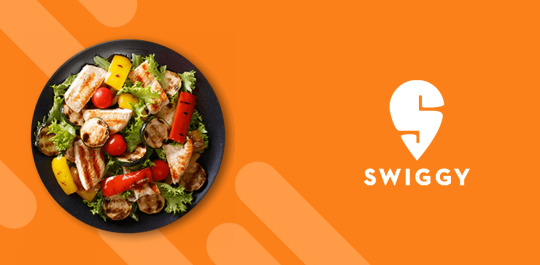
View On WordPress
#delivery app#food delivery#food delivery app#food delivery clone#swiggy app#swiggy business model#swiggy clone app
0 notes
Link
Licious offer the best meat ordering and delivery services. Know about Licious Business Model, and how the Licious delivery app work and makes revenue. We offer Licious Clone for your business.
#Licious business model#Licious clone script#food delivery app#food ordering app#white label food delivery app#food delivery clone script#food clone script
0 notes
Text
the hashira and their phones

☆ what’s their phone like? what’s in there?

tomioka giyuu
does NOT name his contacts
has games but they’re the type of games you’d think are boring like snake and sodoku
his phone is always on silent mode because the ringing shocks him
seen-zones your messages often, either replies in 5 seconds or in 5 days
he uses his note app to make grocery and to do lists
himejima gyoumei
has cats as his home and lock screen
sometimes forgets that siri/alexa is enabled so he gets spooked
one of his fondest memories is when he first got his phone and all the other hashiras entered their number in it
phone has been dropped a couple of times but it’s so sturdy
he has a little cat keychain plugged into the headphone jack of his phone.
rengoku kyojuro
has the latest model phone but doesn’t know how to fully use it
loves to take photos
his lock screen and home screen are the same: rengoku family pic
has premium everything like Spotify premium, YT premium, etc
food delivery app gold membership holder
iguro obanai
has those tempered glass covers that are dark and tinted so you don’t see what he’s doing with his phone from where you’re standing
at first he didn’t want to have a phone case because he likes the grip he has on his phone, but mitsuri insisted he get one so he did
slither.io master
gallery has a lot of pictures of nature but rarely has ones with him in it
phone always on silent, mitsuri in his important contacts
tokito muichiro
uses moving phone lock screens, minimal motions like clouds in the sky or shapes floating around
always forgets to turn off their mobile data or wi-fi so their phone drains fast
blue phone case with mist details, doesn’t have a pop grip
he drops his phone often but coincidentally he either drops them on a soft surface or the fall isn’t strong enough to leave a crack
he says the most satisfying thing about his phone is him taking off the plastic cover from the��screen when he first got it
shinazugawa sanemi
sanemi actually takes very good care of his phone
he knows how expensive they can be so even if his phone is old it still looks good as new
his lock screen is a default image but his home screen is a family pic during genya’s high school graduation
he doesn’t really have games on his phone because he’s too busy but he used to play fruit ninja
his messages are mostly him checking up where his younger siblings are and when they’ll get home
uzui tengen
the noisiest ringtone EVER
has 1000+ unread emails
phone gallery has multiple folders but mostly it’s selfie and groupie folders
when he listens to music he listens to it in full volume
is part of Kyojuro’s premium account family plans
kocho shinobu
butterfly phone case with wavy body for a better grip
overall theme inside is purple and white
family photos in her phone are in her favourites folder
has that beaded hand grip that tangles and hers are made with butterfly beads
phone on silent most of the time but when it isn’t she has a violin cover of a song as her ringtone
kanroji mitsuri
cute games like neko atsume and hungry hearts
she would definitely let kids borrow her phone to play games
her phone gallery is filled with pics of people she loves, food, and pretty clouds
all of her contacts have nicknames and corresponding emojis
she’s the type of person to give her password away to her friends
#mio#anime#anime imagines#anime scenarios#anime headcanons#demon slayer#kimetsu no yaiba#kny#demon slayer headcanons#headcanons#hashira#tomioka giyu#tomioka giyuu#demon slayer imagines
117 notes
·
View notes
Text
From the beginning | Previously | Coin standings


Yes indeedy! That glue reminds you- just to the south of this market square in the medieval village, there's supposed to be a school of some sort. Since you VALUE LEARNING, you should head there next.
But first...
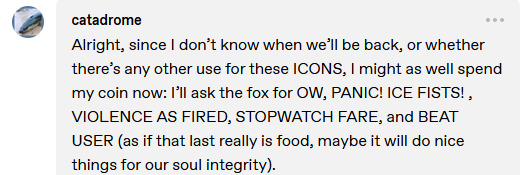
A DEMOCRAT spends a whopping 21 Coin and purchases a bevy of useful items from the fennec in the butterflies. How generous!
The WIFI ACCESS POINT can be installed in a particular area to gain access to the local network, allowing you to browse the files stored there and potentially communicate with users. Once installed, the access point can't be uninstalled, so choose your moment carefully- or save up for a new one.
DENIAL OF SERVICE is a gun! Wait, a gun?! Yeah, a gun. But like, a fake hacking gun that shoots highly concentrated packet bursts at glitches to overwhelm and stun them. It comes with six "bullets".
The SOFTWARE PATCH can be spent to increase your STINGY OUTLIER by 5% with no untoward side effects! It can even clear certain negative statuses.
You've also been delivered something from UBER EATS, a kind of overpriced food delivery app with a questionable business model. Still, beggars can't be choosers. What is this, tikka masala? It's pretty good!
But you are still hungry.
With all that out of the way, you make your way south.

You find something that might've been a school, once- but here it's nothing but a maze of overgrown ruins. Marble and brick buildings have been overtaken by gigantic trees that hungrily envelop anything they can get their roots on, and the halls, as usual, sit empty and devoid of life... that isn't a weird monster falling apart at the seams. You spot a toucan, except instead of a body it just has another beak, forming some sort of horrid banana that appears to be silently begging for death with two lungless mouths. Eegh.
What can you do here?
There's a couple of kids following you- creepy. These FILIAL TWINS are completely identical and finish each other's sentences, which is just plain spooky. Stop that!
There's someone else offering a tour of a factory that turns iron to sugary breakfast cereal. You don't know how that's possible, but you could find out on an IRON CANDY CHEERIOS TOUR.
Hey, an elevator! An elevator that's been booby-trapped to hell and back! WOO, LETHAL LIFT! You bet you'd be completely murdered if you got on this thing. Fun!
That mannequin's here, reminding you that you always have the option to use SECRETARY POSTURE to look your gleaming best for an EVIL DEVIL AGLEAM.
Continued
#lost in hearts#if you remember the ODD TAIL AVATAR coming from a different location: that's a mistake i edited#it came from this spot but i mixed up the relative positions of this spot and the COSY CUB TV MENU route
8 notes
·
View notes
Text
Bangaloreans ka Dabba Gul
The Mumbai Dabbawalas are a remarkable example of an efficient food delivery service that has been operating in the bustling metropolis of Mumbai since the late 1800s. Their primary function is to deliver home-cooked meals from customers’ homes to their workplaces, catering primarily to the city's office workers who crave the comfort of home-cooked food during their busy workdays. The Dabbawalas managed to deliver around 200,000 meals daily, relying on a complex yet effective logistical framework that incorporates traditional methods with an understanding of the local urban landscape. Each Dabbawala is responsible for picking up tiffin boxes filled with freshly prepared meals in the morning, which are then sorted and delivered to the correct locations using a unique color-coded system. This coding system allows them to identify the destination of each tiffin at a glance, ensuring that deliveries are completed with remarkable accuracy. The entire process, from collection to delivery, is meticulously timed, with most Dabbawalas finishing their rounds in under six hours, thanks to their deep familiarity with the city’s geography and public transportation systems.
Transportation plays a crucial role in the Dabbawalas' operations. They primarily take advantage of the city’s local train system to cover greater distances quickly. This multi-modal approach not only increases their efficiency but also allows them to avoid the heavy traffic that can often paralyze the city. Each Dabbawala typically handles around 30 to 40 tiffin’s each day, working in teams to streamline operations further. In recent years, the Mumbai Dabbawalas have faced several challenges that threaten their traditional business model. One significant issue is the increasing competition from modern food delivery services, such as Swiggy and Zomato, which offer a wide variety of cuisines and the convenience of online ordering through apps. These platforms have capitalized on the growing demand for diverse dining options and fast delivery times, drawing customers away from the Dabbawala system, which primarily focuses on home-cooked meals. Additionally, the COVID-19 pandemic posed unprecedented challenges, such as remote working arrangements which drastically reduced the number of office-goers in Mumbai, resulting in a substantial drop in daily deliveries. Furthermore, the increasing cost of living and inflation have impacted their earnings, as the cost of raw materials for the meals has risen, putting additional financial strain on both the Dabbawalas and their customers.
Task at Hand
The Mumbai Dabbawalas have decided to expand to Bangalore and as the CEO of Mumbai Dabbawallas plan your expansion strategy for introducing the service in the ‘IT Hub of India’
Deliverables
A report (minimum 5 pages) and a PPT (minimum 7 slides) consisting of:
1. Business model for the new city
2. Phase Wise Implementation Plan & Growth Strategies
3. Unconventional Marketing Strategies
4. Technological Integration (if any)
5. Outline of your Targeted Locations in Bangalore
6. Financials for the Project.
2 notes
·
View notes
Text
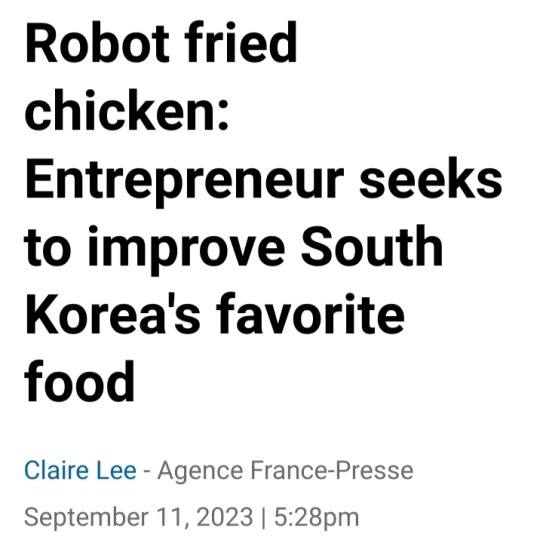
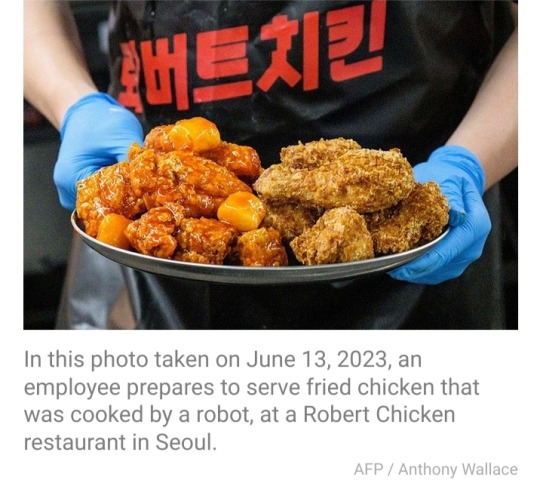
SEOUL, South Korea — In fried-chicken-obsessed South Korea, restaurants serving the nation's favourite fast-food dish dot every street corner.
But Kang Ji-young's establishment brings something a little different to the table: a robot is cooking the chicken.
Eaten at everything from tiny family gatherings to a 10-million-viewer live-streamed "mukbang" -- eating broadcast -- by K-pop star Jungkook of BTS fame, fried chicken is deeply embedded in South Korean culture.
Paired with cold lager and known as "chimaek" -- a portmanteau of the Korean words for chicken and beer -- it is a staple of Seoul's famed baseball-watching experience.
The domestic market -- the world's third largest, after the United States and China -- is worth about seven trillion won ($5.3 billion).
However, labour shortages are starting to bite as South Korea faces a looming demographic disaster due to having the world's lowest birth rate.
Around 54 percent of business owners in the food service sector report problems finding employees, a government survey last year found, with long hours and stressful conditions the likely culprit, according to industry research.
Korean fried chicken is brined and double-fried, which gives it its signature crispy exterior, but the process -- more elaborate than what is typically used by US fast food chains -- creates additional labour and requires extended worker proximity to hot oil.
Enter Kang, a 38-year-old entrepreneur who saw an opportunity to improve the South Korean fried chicken business model and the dish itself.
"The market is huge," Kang told AFP at her Robert Chicken franchise.
Chicken and pork cutlets are the most popular delivery orders in South Korea, and the industry could clearly benefit from more automation "to effectively address labour costs and workforce shortages," she said.
Kang's robot, composed of a simple, flexible mechanical arm, is capable of frying 100 chickens in two hours -- a task that would require around five people and several deep fryers.
But not only does the robot make chicken more efficiently -- it makes it more delicious, says Kang.
"We can now say with confidence that our robot fries better than human beings do," she said.

Investing in 'foodtech'
Already a global cultural powerhouse and major semiconductor exporter, South Korea last year announced plans to plough millions of dollars into a "foodtech" fund to help startups working on high-tech food industry solutions.
Seoul says such innovations could become a "new growth engine," arguing there is huge potential if the country's prowess in advanced robotics and AI technology could be combined with the competitiveness of Korean food classics like kimchi.
South Korea's existing foodtech industry -- including everything from next-day grocery delivery app Market Kurly to AI smart kitchens to a "vegan egg" startup -- is already worth millions, said food science professor Lee Ki-won at Seoul National University.
Even South Korea's Samsung Electronics -- one of the world's biggest tech companies -- is trying to get in on the action, recently launching Samsung Food, an AI-personalised recipe and meal-planning platform, available in eight languages.
Lee predicted South Korea's other major conglomerates are likely to follow Samsung into foodtech.
"Delivering food using electric vehicles or having robots directly provide deliveries within apartment complexes, known as 'metamobility,' could become a part of our daily lives," he said.
"I am confident that within the next 10 years, the food tech industry will transform into the leading sector in South Korea."

'Initially struggled'
Entrepreneur Kang now has 15 robot-made chicken restaurants in South Korea and one branch in Singapore.
During AFP's visit to a Seoul branch, a robot meticulously handled the frying process -- from immersing chicken in oil, flipping it for even cooking, to retrieving it at the perfect level of crispiness, as the irresistible scent of crunchy chicken wafted through the shop.
Many customers remained oblivious to the hard-working robotic cook behind their meal.
Kim Moon-jung, a 54-year-old insurance worker, said she was not sure how a robot would make the chicken differently from a human "but one thing is certain -- it tastes delicious."
The robot can monitor oil temperature and oxidation levels in real time while it fries chicken, ensuring consistent taste and superior hygiene.
When Kang first started her business, she "initially struggled" to see why anyone would use robots rather than human chefs.
"But after developing these technologies, I've come to realise that from a customer's perspective, they're able to enjoy food that is not only cleaner but also tastier," she told AFP.
Her next venture is a tip-free bar in Koreatown in New York City, where the cocktails will feature Korea's soju rice wine and will be made by robots.
youtube
Entrepreneur aims to improve South Korea's dish using robot
11 September 2023
#South Korea#chimaek#fried chicken#beer#Korean fried chicken#Robert Chicken#Kang Ji-young#advanced robotics#AI technology#Samsung Food#Samsung Electronics#metamobility#Youtube#robot
9 notes
·
View notes
Text
How to Start a Grocery Delivery Business
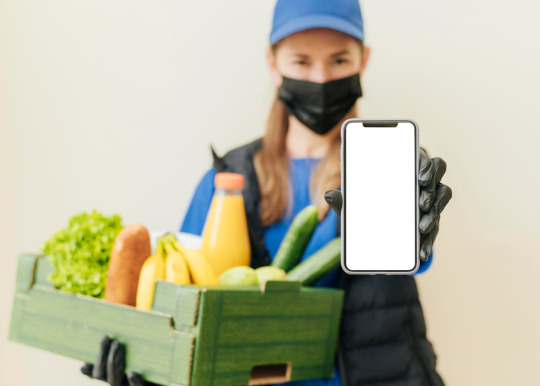
In an instant where convenience is important and online services are influencing consumer habits, starting a grocery delivery business can be a lucrative venture. As the demand for efficient and time-saving solutions continues to rise, this guide will take you through the essential steps to launch and scale your grocery delivery service.
Research on markets
The foundation of a successful grocery delivery business starts with complete market research. Identify your target audience, analyze local competitors, and understand the unique needs of your community. Consider factors such as demographics, shopping behaviors, and existing gaps in grocery delivery services.
Construct a Business Plan
A business plan is an extensive document that describes the objectives, tactics, and day-to-day activities of a company. A well-researched business plan will serve as your roadmap, outlining your goals, strategies, and financial projections.
Create a robust business model
Choose a business model that aligns with your goals and resources. You can opt for a partnership with local grocery stores, source products independently, or adopt a hybrid approach. Evaluate the pros and cons of each model, considering factors such as costs, logistics, and customer preferences.
Build a user-friendly app or website.
Invest in a user-friendly and intuitive platform to facilitate seamless interactions between customers, your service, and partnered grocery stores. Develop a mobile app or website that allows users to browse products easily, create shopping lists, and place orders with a few taps or clicks. Ensure secure payment gateways and implement features like order tracking and notifications to enhance the overall user experience. If you’re planning to develop a web or app, know the costs of developing a grocery delivery app.
Establish strong supplier relationships.
Develop solid partnerships with local grocery stores or wholesalers to ensure a consistent and diverse product supply. Negotiate pricing, delivery schedules, and terms to build a mutually beneficial relationship. Reliable suppliers are crucial to maintaining a well-stocked inventory and meeting customer expectations.
Implement Efficient Logistics and Delivery Systems:
Efficient logistics and reliable delivery systems are the backbone of any successful grocery delivery business. Develop a streamlined process for order fulfillment, consider partnering with third-party delivery services if needed, and optimize delivery routes for time and cost efficiency. Communicate delivery times and ensure your delivery team is well-trained in customer service and hygiene practices.
Emphasize Quality Customer Service:
Excellent customer service is a key differentiator in the competitive grocery delivery landscape. Provide responsive customer support through various channels, such as live chat, email, or phone. Address customer queries, concerns, and feedback promptly to build trust and loyalty. A positive customer experience is likely to result in repeat business and positive word-of-mouth referrals.
Implement marketing and promotion strategies:
Create awareness for your grocery delivery business through targeted marketing and promotions. Utilize social media platforms, local advertising, and partnerships with influencers to reach a wider audience. Offer promotions, discounts, and loyalty programs to encourage both new and repeat customers.
Ensure regulatory compliance.
Understand and comply with local regulations regarding food handling, safety, and business operations. Obtain any necessary licenses or permits to operate legally. Compliance with industry standards not only safeguards your business but also instills confidence in customers regarding the safety and legitimacy of your service.
Optimize Technology for Analytics:
Make use of technology to gather and analyze data on customer preferences, purchasing patterns, and market trends. Use this information to make informed decisions, refine your product offerings, and customize marketing strategies. A data-driven approach can significantly contribute to the growth and sustainability of your grocery delivery business.
Scale and innovate:
As your business gains traction, explore opportunities for expansion and innovation. Consider adding new features to your app, expanding your delivery area, or introducing subscription models. Stay abreast of industry trends and technological advancements to remain competitive in the ever-evolving grocery delivery landscape.
Conclusion:
Starting a grocery delivery business requires careful planning, dedication, and a customer-focused approach. Grocery delivery services are becoming more and more in demand, and you can meet this demand by developing a streamlined and efficient service, applying technology, and understanding your market. Follow these steps, adapt to changing consumer preferences, and watch your grocery delivery business thrive in an era where convenience is king.
2 notes
·
View notes
Text
Top 5 Food Delivery Business Ideas Using UberEats Clone App
In the dynamic world of #fooddelivery, innovation is key to standing out and capturing a loyal customer base. With the rise of #UberEats clone apps, entrepreneurs can enter the market with a proven model and #customize it to their unique vision.
Here are the top 5 food delivery business ideas to consider:
#app development#ubereats#food#food delivery software#food ordering software#restaurnats#cookinghouse#blog#business model#digital transformation#cloudkitchen#online food delivery
0 notes
Text
It’s also the kind of instant gratification business that for a brief moment in recent years seemed to have the potential to change e-commerce forever. “We’d build a plan and they’d [investors would] say you’re not spending enough,” Ilishayev says. “It’s easy to get caught up when you’re having a lot of things go right.”
Gopuff is part of a class of startups that soared during the pandemic, trying to solve a logistics and math puzzle that’s dogged Silicon Valley for decades: Can an e-commerce company whisk products to your house in under an hour? And more important: Can it actually make money doing so?
Flying cars and nuclear fusion it certainly isn’t. But the problem has confounded nearly everyone who’s tried to solve it, starting in the 1990s with Kozmo.com, whose bike messengers swarmed New York and a handful of other cities, offering free one-hour delivery of everything from magazines to 16-ounce Cokes, before it was vaporized in the dot-com crash. Two decades later, Covid-19 lockdowns created the perfect conditions for the model to finally work—billions of people trapped at home, desperate to have anything and everything delivered as quickly as possible, for almost any price. Nearly $10 billion of venture capital gushed into so-called quick commerce companies like Gopuff and the Istanbul-based Getir in 2021, according to PitchBook Data Inc. That didn’t include the exponential growth of delivery apps like DoorDash, Uber Eats, and Instacart, which ferried food from restaurants and supermarkets. Meanwhile, the biggest deliverer of all, Amazon.com Inc., was notching a 40% annual growth rate.
Gopuff, which had been kicking around since 2013, emerged with a different strategy than its DoorDash ilk, mostly middlemen apps that relied on a contract workforce and often skimmed a margin of up to 40% from the restaurants and retailers they made deliveries for. Instead, Gopuff had an Amazon-like approach of storing and stocking products in its own mini warehouses staffed by full-time employees, then using contractors to deliver products to people’s doorstep for $1.95 an order. Its founders, Ilishayev and Yakir Gola, each now 29, got to know each other when they were undergrads at Drexel University, where they started an online business selling hookahs and other smoking paraphernalia to other college kids (early slogan: “Puffin’ has never been this easy”). It wasn’t until 2015 that they entered the booze business, charging an additional $2 fee per order for alcohol, and gradually expanded their assortment and ambition.
By early 2020, Gopuff had 165 warehouses covering some 600 US cities. Then, in the span of two years, the startup raised an astounding $3 billion in venture capital from the likes of SoftBank Group Corp.’s infamous Vision Fund, acquired the 28-year-old liquor retailer BevMo!, and expanded into Europe by buying two smaller competitors. By 2021 its valuation had risen to a hyperbolic $15 billion, and the founders had cashed out by selling some of their shares to investors. They bought a private plane and decamped from Philadelphia to intracoastal mansions in Miami.
Paywall Free version here.
8 notes
·
View notes
Text
Amazon and Grubhub Partnership
Amazon has a new partnership with Grubhub (owned by Just Eat Takeaway) so now Amazon is back in the restaurant delivery business.
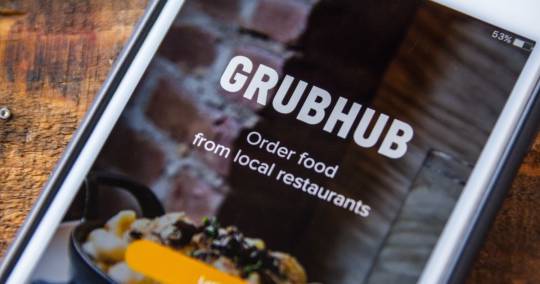
Amazon tried restaurant delivery but exited the business in 2019 after trying it for four years. The original plan in 2015, was to compete with Grubhub and other food delivery services. Amazon Prime members could place orders for food from restaurants and have it delivered with no delivery fees. Amazon seemed dedicated to this because they even had a division at Amazon called Amazon Restaurants.
Amazon apparently identified the restaurant delivery business as a strategic uncertainty and decided to exit the business. Amazon must have assessed the risk of negative impact to be very high. In my opinion, the timing of the exit was unfortunate because the Covid lockdowns began shortly after their exit from the food delivery business. But Amazon also apparently decided to monitor the food delivery industry after exiting because only 3 years later they are back in the business.
Another point of view is that Amazon could have been simply testing the industry, learning what they wanted to learn in the food delivery business then after the trial, decided there was a better way to make a profit in this category. Buying into a partnership instead of owning a restaurant delivery business might have been assessed to be a better use of Amazon resources. Grubhub is an established brand with experience and knowledge in the restaurant delivery business so maybe this partnership is a smart strategic move for both brands.
The timing for the re-entry into food delivery makes sense due to a change in the way we live, work, and eat as a result of the Covid pandemic. Food delivery services such as Instacart, Uber Eats, Deliveroo and Door Dash all experienced an acceleration in orders during the Covid lockdown. Although the surge in demand ceased, data on the food delivery services indicates that consumers who tried food delivery services during the lockdown liked what they tried.
Since Amazon started in the restaurant delivery business in 2015, the market has changed. There is more consumer demand but there is also more competition from other food and restaurant delivery services.
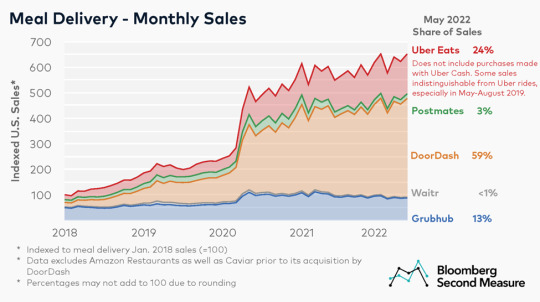
This graph shows that with the increase in demand comes new competitors and changes in market share. This is very characteristic of the growth stage of the Product Life Cycle (PLC) and this means all competitors will be shifting marketing strategies to defend their market share.
I find it interesting that Amazon is entering the fray (again) when there are so many competitors with more significant expertise than them in the food delivery category. They now have to compete against Door Dash’s 59 % market share and Uber Eats 24% market share.
Since Grubhub has only 13% market share, a big question I have is this: why Grubhub?
According to data published in Tech Crunch, Grub Hub has experienced consistent growth in Revenue each year since 2010. In 2010, Grubhub generated $8.5 million in revenue. At the end of 2021, Grubhub generated $2.1 Billion in annual revenue. That is impressive revenue for Grubhub and since Grubhub has the business model set up, it should be easy for Amazon to generate significant revenue without spending too heavily on existing Amazon resources. Additional impressive data about Grubhub is growth in the number of users. According to the chart below, Grubhub had 3.4 million users in 2013, at the end of 2021, Grubhub had 33.8 million users who purchase through the app once a month.Sources: Company data, Food Delivery App Report, TechCrunch.
Although Grubhub is a growing delivery business, I wonder what criteria Amazon used in their choice of Grub Hub. It is clear that Grub Hub has been consistently growing revenue and has grown in terms number of users but there must be something else that Amazon sees in this partnership. From a growth perspective, this is a good business for Grubhub but I still wonder what else Amazon knows about Grub Hub to make this their choice.
Although overall growth has been good for Grub Hub, their quarterly sales per customer has not seen the increase that competitors have seen (more than doubled for Uber Eats and Door Dash).

I have a lot of questions about Amazon’s decision. Why not go it alone? Do they still assess this as a strategic uncertainty and they are trying to minimize risk of failure?
Is it possible that their timing was wrong when they first tried this? Consumer patterns have changed since the pandemic and maybe many people that tried food delivery then found that they really benefit from a service like this and do it more often. Is it possible that more people like to eat at home than before and delivery gives people a restaurant food experience at home? Or, is it possible that Amazon did not give restaurant delivery a chance? What are their criteria for exiting a business?
The part that doesn’t make sense to me is the re- entering the restaurant delivery business after exiting only 3 years ago. This is Amazon, and we assume they have the talent, resources, assets etc. to have monitored the situation, gathered data, make changes, continue on without an exit from the business.
There are many more questions about Amazon’s decision. Was it a strategic decision (and brilliant) to partner with Grub Hub and essentially purchase their expertise, data, market share and revenue? Does this allow them to monitor this strategic uncertainty using fewer of their own resources? Was the original restaurant delivery business part of an experiment with something they will never reveal? Is the new Grubhub partnership and efficient way to offer Amazon Prime subscribers a new benefit at little cost to Amazon?
In my opinion, the re-entry is another test to gather data for something bigger in Amazon’s strategic plan for growth. In the meantime, they will have another benefit to add to the list of Amazon Prime membership benefits.
I look forward to following this story .
Sources:
https://techcrunch.com/2015/09/08/amazon-launches-a-food-delivery-service-via-prime-now-starting-in-seattle/
https://techcrunch.com/2019/06/11/amazon-restaurants-in-u-s-is-shutting-down/
https://techcrunch.com/2022/07/06/amazon-takes-a-prime-step-back-into-restaurant-delivery-in-the-us-with-new-grubhub-investment-and-partnership/
https://www.restaurantdive.com/news/amazon-restaurants-is-dead-but-the-e-tailer-is-still-hungry-for-food-deliv/556902/
3 notes
·
View notes
Text
Takin' Care of Business
Have you heard? Billionaire super genius Elon Musk bought Twitter for $44 billion and it might go bankrupt before the year ends. That has to be some kind of record. I wish I had that kind of money to throw away. Is it because the company was already in the dumper? No, it was because he immediately made several brilliant decisions regarding the company and they were, how do I say this, not good.
I heard rumors there are other big companies he is looking to buy and weave his magic with, so to get out in front of it I reassembled my crack team of interns. It is a good time to pay them because they will then have money to buy me Christmas gifts. Each will be getting a generous Crypto payout courtesy of FTX. I am still trying to track down two of them. One usually hangs out at the park staring at ducks and the other likes to dress up like a duck. With any luck I will find the two of them at the same place.
So what did they find? Real interesting stuff or I wouldn't be mentioning it to you. Let's take a stroll down Wall Street and see what else is on his shopping list.
Skip the Dishes. He figures one of the bigger expenses is the delivery of the food so he is going to scrap that part of the business model. People don't mind paying a premium price to go pick up their own food do they?
Disney. Mickey gone. Donald gone. Goofy gone. Huge salary savings. He will keep Minnie, Daisy and all the princesses. That's not creepy is it?
MacDonald's. Margins are small on burgers so he will concentrate on fries and drinks and eliminate burgers. Mayor McCheese is gone as he wants no other people with any authority around. To connect with what is happening in the world Ronald MacDonald will go to Sweden and come back as Rhonda MacDonald. He will keep Hamburglar around as his skills might come in handy. He might bring back their pizza because he likes pizza.
Wal-Mart. He can't cut staff because there is none, so that leaves only one way to increase his profits: He will raise their prices across the board. That makes sense. No one shops based on pricing.
Tim Horton's. This one is on the maybe pile because he knows nothing about Canada. Doesn't want to take a chance because, as he put it 'How much coffee can people drink and how many donuts can they eat?' It is good to be cautious.
Apple. He figures he can make more money by removing the App from Apple. If the phones have fewer Apps they will be cheaper to make and therefore the profit margins will soar.
The U.S. Presidency. How can he buy that you ask? Isn't that how it is done now I ask back? His plan is to sever ties with all of their allies, align with dictators, cut all social programs and...wait, that sounds familiar. Have we seen this movie before?
THOUGHT OF THE WEEK: If you don't know how to do something, don't do it.
2 notes
·
View notes
Text
Online Food Delivery Services Market Size 2023 Global Industry Share, Top Players, Opportunities And Forecast To 2033
The online food delivery services market size is anticipated to advance, attaining a value of US$ 41.94 billion in 2023. According to a market analysis of online on-demand food delivery services, usage is expected to develop at a CAGR of 10% until 2033. By 2033, the online food delivery services market is projected to reach a value of US$ 101.32 billion at the current pace of growth.
Customers are moving online rapidly, which has led to exponential expansion in the e-commerce sector. These changes in consumer shopping patterns result from various factors, some of which are industry or nation-specific, while others are the result of global trends.
Information Source: https://www.futuremarketinsights.com/reports/online-food-delivery-services-market
Mobile Internet and 5G Reshape the Online Food Delivery Landscape
Customers now have access to an array of various applications, including online meal delivery services, owing to improved network connectivity and an upsurge in cell phones. Users of smartphones can easily make orders with their chosen eateries by browsing a list of establishments. Even the most isolated regions now have smartphones. The opinions of online ordering have changed as a result of how simple it is to set up meal delivery apps on smartphones.
Globally, the number of people using mobile internet has significantly increased. Rapid network infrastructure development has increased network connectivity across developing nations, making remote access to mobile applications possible. The introduction of 5G technology enables faster surfing speeds to improve the online ordering experience and create fresh potential for food delivery services online market expansion.
Challenges and Opportunities with Commission Rates for Online Food Delivery Services
Restaurants are significantly constrained by the commission fees imposed by delivery platforms, which can be anywhere between 15 and 30% of the cost of a meal. These commissions’ controversial nature has been highlighted by certain American governments placing caps on them. Platforms have experimented with different restaurant commission rates and terms to allay these worries, but the results are still up in the air.
The spread of “dark kitchens” and delivery-focused business models complicates the problem. Since they have reduced overhead expenses, these models may more easily handle high commissions and frequently have higher visibility on platforms. As a result, they can displace conventional eateries and take a larger portion of the online food delivery services market. The gloomy kitchens present a chance for conventional restaurants to adjust by opening far-off delivery-only locations.
The dynamics of the restaurant sector are being altered by legislative measures, platform agreements, and the emergence of delivery-first business models, all of which significantly impact commission rates on restaurants.
“The future of online food delivery services is wider than cost-effective operations. New operating models are likely to surface. Niche markets, including online grocery and alcohol delivery services, could catch up with the momentum and be instrumental revenue streams for market players,” opines a lead analyst at FMI.
Key Takeaways
The United States online food delivery market to acquire a market share of 23.5% by 2023.
By 2023, Germany is going to retain an 8.5% online on-demand food delivery services market share.
Japan may keep striving to possess a 4.7% online food delivery services market share by 2023.
By 2023, Australia may own 2.6% of the market share.
By 2023, the United Kingdom may hold 6.2% of the online fast food delivery services market.
China online food delivery services industry to record a CAGR of 12.5% through 2033.
India online food delivery market to register a CAGR of 3.1% through 2033.
The platform-to-consumer sector is anticipated to grasp 60% of the global market by 2023.
Over the projection period, platform to consumer distribution is anticipated to flourish at a CAGR of 9.8%.
In 2023, it is predicted that the category of mobile apps may possess 38% of the global market share.
Over the anticipated period, the mobile application segment is anticipated to develop at a CAGR of 9.7%.
Competitive Analysis
There is fierce competition in the online on-demand food delivery services market. Expansion, mergers & acquisitions, and partnerships to achieve consolidation and enhance their offers are the main tactics used by businesses to strengthen their market dominance.
Recent Advancements
Acquisition
Delivery Hero SE paid USD 150 million for Hugo’s food and grocery delivery verticals in October 2021. The acquisition aims to broaden the company’s presence in the Caribbean and Central American regions.
Just Eat Takeaway.com acquired Grub Hub in June 2021 to enter the online meal delivery services market in the United States. This acquisition aims to help the larger group get access to the world’s most appealing online meal delivery markets, including the United States, the United Kingdom, the Netherlands, and Germany.
Key Online Food Delivery Manufacturers
Deliveroo
DoorDash
Foodpanda
GrubHub
Just Eat Holding Limited
Postmates Inc.
Swiggy
Takeaway.com
Zomato
Uber Technologies Inc.
Key Segments
By Delivery Type:
Restaurant-to-Consumer
Platform-to-Consumer
By Channel Type:
Website/Desktop
Mobile Application
By Payment Method:
Cash On Delivery
Online
By Region:
North America
Latin America
Europe
Asia Pacific Excluding Japan
Japan
The Middle East & Africa
0 notes